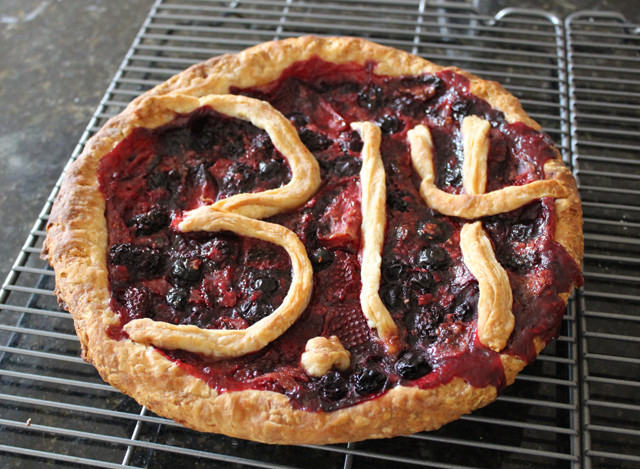
by John Copeland Friday, March 2, 2018

MIT's Experimental Study Group often bake pie as a way to celebrate Pi Day. Credit: Evan Shelhamer, CC BY 2.0.
March hosts a number of special days: St. Patrick’s Day, Johnny Appleseed Day, the Spring Equinox and, one of my favorites, March 14, which is both the birthday of the father of modern physics, Albert Einstein, and also Pi Day, which celebrates the mathematical constant 3.14 that features in some of Einstein’s equations.
Humanity has been contemplating pi for roughly 4,000 years — since humans first sought to quantify the ratio of a circle’s circumference to its diameter, and thus found pi. Pi, it turned out, was also handy in calculating a circle’s area, and, as time passed, it was found to be useful in trigonometry, physics, statistics, cosmology and fluid dynamics, to name just a few fields.
As far back as 1900 B.C., ancient Babylonians found that pi’s value was roughly three. Greek mathematician Archimedes figured out that pi was slightly bigger than 22/7. Today, it is commonly taught in schools as 3.14, though enthusiasts can take the number out to as many decimal places as they’d like. So far, computers have calculated it out to 10 trillion digits — perhaps a bit over the top.
A couple of years ago, I happened to be visiting MIT’s Experimental Study Group (ESG) program on March 14. At nearly 50 years old, ESG is the oldest of the four freshman learning communities at MIT. Freshmen students enrolled in ESG tackle the first-year core subjects of biology, chemistry, humanities, mathematics and physics in small group settings as an alternative to large lecture classes. The ESG facilities foster an open and relaxed environment in which to learn and socialize, including a lounge with a complete kitchen — important since food often plays a part in the ESG learning process.
I have long been aware of Pi Day, but I had never been somewhere that really celebrated the day. At ESG, the students and many of the staff and faculty were wearing pi-themed T-shirts and buttons. But the best part of their celebration was found in the kitchen where several different kinds of pie were on offer — even Italian ones in the form of pizza.
Now, I firmly believe that there are cake people and there are pie people. I am a pie person — cherry is my favorite — and I can eat a lot of it, and even more pizza. And so can 50 or so freshmen, so before long there were only empty pie tins spread across the ESG kitchen counters. It was a wonderful celebration, and left me with a feeling of true satisfaction and happiness as I consumed my share of pie. And that brings me back to Albert Einstein.
While his scientific feats are legendary, there is so much more to know about Einstein than just his work. In 1915, he published his theory of general relativity, which has proven to be one of the best tools for understanding the universe, black holes, time expansion, gravitational waves and other astronomical phenomena we’ve discovered. Then, seven years later, in October 1922, Einstein formulated another theory, one that wasn’t exactly related to physics, nor was it carefully detailed in a scholarly publication.
Einstein was in Tokyo on a lecture tour when he was informed by telegram that he would be receiving the Nobel Prize. When a bellboy arrived at Einstein’s door to deliver the message to him, Einstein realized he didn’t have any money to tip the messenger. Instead, Einstein offered a tip in the form of his theory on how to have a happy life, which he quickly jotted down, in German, on a piece of stationery from the Imperial Hotel in Tokyo:
“A calm and modest life brings more happiness than the pursuit of success combined with constant restlessness.” On a second sheet, he wrote, “Where there’s a will, there’s a way.”
Einstein allegedly offered these notes to the bellboy, apologetically, in lieu of a tip, and told the bellboy if he was lucky, the notes might someday be more valuable than a regular tip. His words, befitting a man who had transformed our comprehension of the universe, were prophetic.
Ninety-five years later, in October 2017, Einstein’s theory of happiness was sold at auction for $1.56 million, making him one of the world’s most generous tippers. The second note sold for $250,000, according to the auction house. The seller was reportedly a relative of the bellboy.
Far less has been written about Einstein’s theory of happiness than his scientific theories, but that doesn’t mean scientists haven’t studied it. In one of the most detailed scientific explorations of happiness and success that I’ve read, published in 2005 in Psychological Bulletin, researchers reviewed 225 studies and concluded that happy people are generally more successful than unhappy people, due in large part to their positive emotions and outlooks: Happiness leads to success, rather than success leading to happiness.
On that note, I’m going to enjoy a piece of cherry pie on March 14, which will give me a hefty dose of happiness.
© 2008-2021. All rights reserved. Any copying, redistribution or retransmission of any of the contents of this service without the expressed written permission of the American Geosciences Institute is expressly prohibited. Click here for all copyright requests.